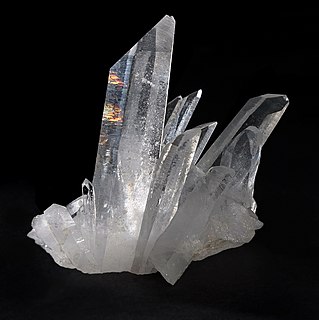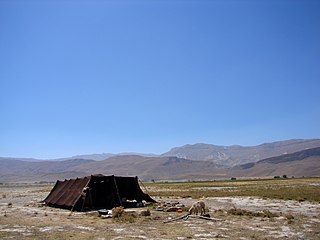
Ninja miner is a nickname for a person who digs small unauthorized mines or pans dirt for gold in Mongolia. [1] The miners are so named because the green bowls they use for panning, when carried on their backs, are said to resemble the shells of the Teenage Mutant Ninja Turtles. [1] [2] [3]

A nickname is a substitute for the proper name of a familiar person, place, or thing - commonly used for affection.

Mining is the extraction of valuable minerals or other geological materials from the earth, usually from an ore body, lode, vein, seam, reef or placer deposit. These deposits form a mineralized package that is of economic interest to the miner.

Gold panning, or simply panning, is a form of placer mining and traditional mining that extracts gold from a placer deposit using a pan. The process is one of the simplest ways to extract gold, and is popular with geology enthusiasts especially because of its low cost and relative simplicity.
Many ninja miners are Mongolians who lost their jobs after the fall of Communism in Mongolia and became traditional herders. In 2001 and 2002 Mongolia faced two harsh winters (known as dzuds), and a third of the country's livestock was lost. Thousands of families took up ninja mining, and searched for quartz or gold on properties large mining companies deemed unmineable. [3] The ninja mining process starts by a group of miners (up to four) digging a hole usually 10–15 feet (3.0–4.6 m) deep using iron stakes, or until reaching a depth with a high gold content. Holes that are near to each other are connected underground. Upon completion of the hole one ninja miner works at the bottom of the hole by candlelight, digging up dirt, while another pulls dirt to the surface to be sifted by yet another ninja miner. [1]

A zud or dzud is a Mongolian term for a severe winter in which large number of livestock die, primarily due to starvation due to being unable to graze, in other cases directly from the cold. There are various kinds of zud, including white zud, which is an extremely snowy winter in which livestock are unable to find nourishing foodstuff through the snow cover and starve.

Quartz is a mineral composed of silicon and oxygen atoms in a continuous framework of SiO4 silicon–oxygen tetrahedra, with each oxygen being shared between two tetrahedra, giving an overall chemical formula of SiO2. Quartz is the second most abundant mineral in Earth's continental crust, behind feldspar.
In 2003 there were approximately 30,000 ninja miners in Mongolia, [1] which increased to 100,000 in 2007. [3] Ninja miners earned an average of $10 a week in 2003, [1] which increased to $5–10 per day in 2007. [3] Students on summer break often work with their parents to help pay tuition. The largest ninja mining area is at Zaamar, a five-hour drive from Ulan Bator. [1]

The United States dollar is the official currency of the United States and its territories per the United States Constitution since 1792. In practice, the dollar is divided into 100 smaller cent (¢) units, but is occasionally divided into 1000 mills (₥) for accounting. The circulating paper money consists of Federal Reserve Notes that are denominated in United States dollars.

Zaamar is a sum of Töv Province in Mongolia.
Ninja Mining is having an adverse effect on agriculture, as nomadic herders are having to move more frequently to find land for their livestock to graze on due to the increase in holes and the reduced amount of grass. This combined with the northward expansion of the Gobi Desert is causing some herders to reduce their herd to focus on higher quality livestock, while others are giving up nomadism and moving setting up farms and cooperatives. Peter Morrow, the CEO of Khan Bank (the former state agricultural bank) said this could be the end of traditional herding in Mongolia, "the last horse-based nomadic culture in the world". [3]

The Gobi Desert is a large desert or brushland region in Asia. It covers parts of Northern and Northeastern China, and of southern Mongolia. The desert basins of the Gobi are bounded by the Altai Mountains and the grasslands and steppes of Mongolia on the north, by the Taklamakan Desert to the west, by the Hexi Corridor and Tibetan Plateau to the southwest, and by the North China Plain to the southeast. The Gobi is notable in history as part of the great Mongol Empire, and as the location of several important cities along the Silk Road.
An episode of the Animal Planet series River Monsters filmed in Mongolia mentioned ninja miners; a local guide mentioning that ninjas will aggressively defend their claims from intruders.

Animal Planet is an American pay television channel owned by Discovery, Inc. First established on October 1, 1996, the network is primarily devoted to series and documentaries about wild animals and domestic pets.

River Monsters is a British and American wildlife documentary television programme produced for Animal Planet by Icon Films of Bristol, United Kingdom. It is hosted by extreme angler and biologist Jeremy Wade, who travels around the globe in search of the most fearsome freshwater killers, looking for clues, eyewitnesses, and stories about people who were dragged underwater by these vicious predators, he tries to catch the biggest specimens and then release them back into the wild. His aim is to help people understand the truth behind the animals' attacks on humans to save these rare creatures from extinction.
A feature-documentary Price of Gold [4] (Sven Zellner, Chingunjav Borkhuu; D 2012) ARTE - Dokumentarfilmpreis Duisburger Filmwoche [5] - HotDocs Toronto 2012, official selection World Showcase. [6] [7]
A photo-essay "Ninjas" by Sven Zellner and Building Sand Castles on the Steppe? Mining, Herding and Water Governance in the Gobi by Jennifer Lander and photographer Sven Zellner [8]













